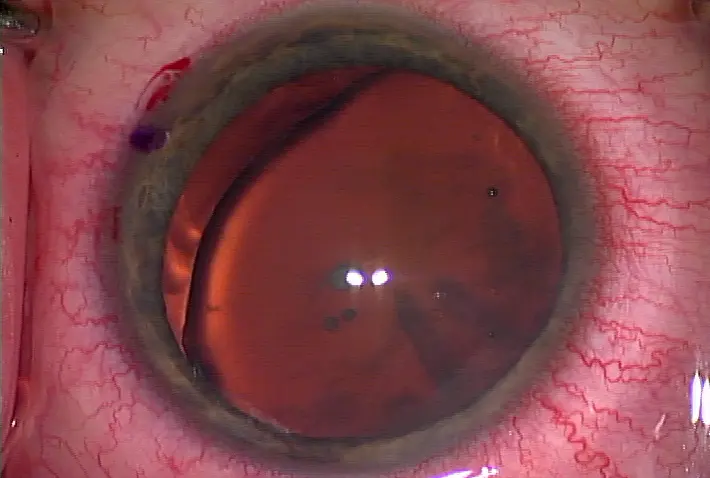What shallow really means
August 2010‧EyeWorld
What shallow really means
by Matt Young EyeWorld Contributing Editor
Traditionally, factors such as high ultrasound energy, advanced age, and high nucleus grade have increased the risk for endothelial cell loss, but researchers may have hit on something a little different.
A shallow anterior chamber has not been associated with endothelial cell loss, according to some research, but now ophthalmologists have found that shallow anterior chamber depth (ACD) combined with certain surgical scenarios, like a long corneal tunnel, could indeed increase one's risk for endothelial cell loss.
" shallow ACD leads to phacoemulsification being performed closer to the endothelium and may therefore be associated with an increased risk of endothelial cell loss," according to study co-author Man Soo Kim, M.D., Ph.D., Department of Ophthalmology, Catholic University of Korea, Seoul St. Mary Hospital, Seoul, Korea. The study was published online in February in the Korean Journal of Ophthalmology.
The evidence
Dr. Kim analyzed 94 eyes of 94 patients who underwent phacoemulsification. They were studied at day one, week one, week six, and week 12 post-op. Eyes were also divided into three different ACD groups; ACD I, 1.5
"Before ACD stratification of all eyes, neither ACD nor axial length was associated with percentage decrease in endothelial cell density at 1 day, 1 week, 6 weeks, and 12 weeks postoperatively," Dr. Kim reported.
However, certain factors emerged as relevant to endothelial cell loss within certain ACD groups. In ACD I (the shallow ACD group), significant factors for decreasing endothelial cell density at all follow-up periods were nucleosclerosis, tunnel length, and phaco energy.
Meanwhile, for ACD II, significant factors for decreasing endothelial cell density were nucleosclerosis, tunnel length, and phaco energy at day one and week one, but only phaco energy was significant at week six and week 12.
In ACD III, significant factors were nucleosclerosis (at day one and week one), phaco energy, and nucleosclerosis (week six and 12).
Clearly, the most interesting result is tunnel length in shallow ACD eyes. "During lens phacoemulsification, if the tunnel created is longer than necessary, the phaco tip tends to work uphill involuntarily," Dr. Kim reported. "In hyperopic eyes, the corneal endothelium may potentially be closer to the phacoemulsification tip than it would be in a normalized eye due to the crowding of the anterior chamber, so long corneal tunnel length is associated with an increased risk for endothelial cell loss due to involuntary uphill work."
That's not to say that short tunnel length is always better, as it can be associated with wound leakage, Dr. Kim noted. Corneal tunnel length nonetheless remains a concern in shallow ACD eyes. "In short ACD eyes, corneal tunnel length was a major risk factor that can affect the decrease of corneal endothelial cell density throughout a 12 week postoperative follow-up," Dr. Kim reported. "In eyes with middle range ACD, corneal tunnel length was a risk factor for endothelial cell density only on postoperative day 1 and week 1. In long ACD eyes, corneal tunnel length was not associated with a decrease of endothelial cell density."
Risk factors, therefore, appear to be different for endothelial cell loss based on different anterior chamber depths. "Corneal incisional tunnel length, an intraoperative factor that can be influenced by the sharpness of the blade, the angle of approach of the blade and the thickness of corneal tissue can be a risk factor for endothelial cell loss," Dr. Kim reported. "Therefore, short corneal tunnels are indicated to reduce early postoperative endothelial cell loss in short ACD eyes."
Randall E. Cole, M.D., medical director, Boozman-Hof Eye Surgery and Laser Center, Rogers, Ark., said it makes sense that long corneal tunnels in shallow ACD eyes increase the risk for endothelial cell loss. "In shallow ACD eyes, you're obviously going to be doing phaco and using energy closer to the endothelium," Dr. Cole said. "In that setting, it's a good idea not to make a long tunnel."
Dr. Cole prevents endothelial cell loss by using the viscodispersive agent Viscoat (sodium chondroitin sulfate, sodium hyaluronate, Alcon, Fort Worth, Texas). He also likes Healon 5 (sodium hyaluronate, Abbott Medical Optics, Santa Ana, Calif.)—especially when there is a thick brunescent lens in a shallow ACD.
Post-op, it's important to keep the eye as quiet as possible in terms of inflammation, he said. Treating any pressure rise on day one or two post-op as needed is important as well. "A pressure in the 40s or 50s is going to be damaging to the endothelium," Dr. Cole said.
"Overall, your approach to surgery configuration of the incision, [a lower] amount of phaco energy, [chamber] protection, maintaining a deep chamber, post-op maneuvers to minimize iritis, inflammation, and retained cortex, and monitoring post-op pressure all give a cornea a better chance."
Editors' note: Dr. Kim has no financial interests related to this study. Dr. Cole has no financial interests related to his comments.
Contact information






留言
張貼留言